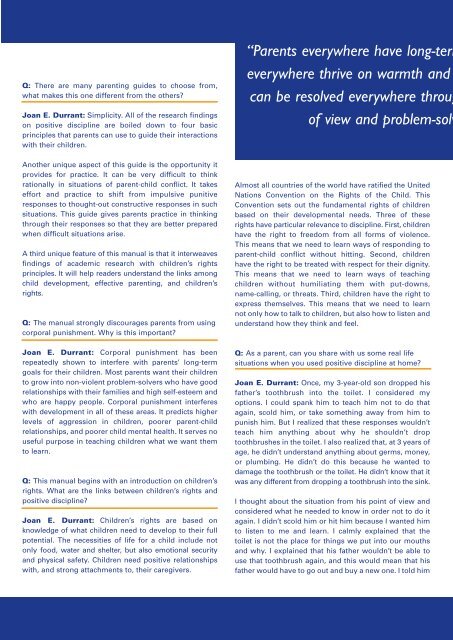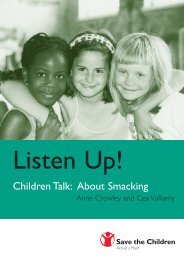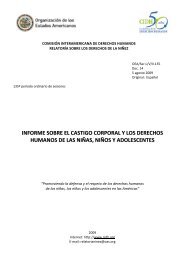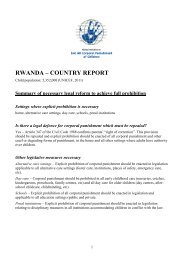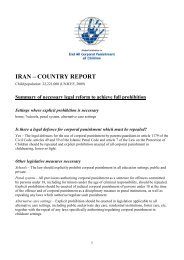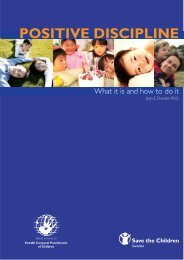Interview with the Author - Global Initiative to End All Corporal ...
Interview with the Author - Global Initiative to End All Corporal ...
Interview with the Author - Global Initiative to End All Corporal ...
You also want an ePaper? Increase the reach of your titles
YUMPU automatically turns print PDFs into web optimized ePapers that Google loves.
Q: There are many parenting guides <strong>to</strong> choose from,what makes this one different from <strong>the</strong> o<strong>the</strong>rs?Joan E. Durrant: Simplicity. <strong>All</strong> of <strong>the</strong> research findingson positive discipline are boiled down <strong>to</strong> four basicprinciples that parents can use <strong>to</strong> guide <strong>the</strong>ir interactions<strong>with</strong> <strong>the</strong>ir children.Ano<strong>the</strong>r unique aspect of this guide is <strong>the</strong> opportunity itprovides for practice. It can be very difficult <strong>to</strong> thinkrationally in situations of parent-child conflict. It takeseffort and practice <strong>to</strong> shift from impulsive punitiveresponses <strong>to</strong> thought-out constructive responses in suchsituations. This guide gives parents practice in thinkingthrough <strong>the</strong>ir responses so that <strong>the</strong>y are better preparedwhen difficult situations arise.A third unique feature of this manual is that it interweavesfindings of academic research <strong>with</strong> children’s rightsprinciples. It will help readers understand <strong>the</strong> links amongchild development, effective parenting, and children’srights.Q: The manual strongly discourages parents from usingcorporal punishment. Why is this important?Joan E. Durrant: <strong>Corporal</strong> punishment has beenrepeatedly shown <strong>to</strong> interfere <strong>with</strong> parents’ long-termgoals for <strong>the</strong>ir children. Most parents want <strong>the</strong>ir children<strong>to</strong> grow in<strong>to</strong> non-violent problem-solvers who have goodrelationships <strong>with</strong> <strong>the</strong>ir families and high self-esteem andwho are happy people. <strong>Corporal</strong> punishment interferes<strong>with</strong> development in all of <strong>the</strong>se areas. It predicts higherlevels of aggression in children, poorer parent-childrelationships, and poorer child mental health. It serves nouseful purpose in teaching children what we want <strong>the</strong>m<strong>to</strong> learn.Q: This manual begins <strong>with</strong> an introduction on children’srights. What are <strong>the</strong> links between children’s rights andpositive discipline?Joan E. Durrant: Children’s rights are based onknowledge of what children need <strong>to</strong> develop <strong>to</strong> <strong>the</strong>ir fullpotential. The necessities of life for a child include no<strong>to</strong>nly food, water and shelter, but also emotional securityand physical safety. Children need positive relationships<strong>with</strong>, and strong attachments <strong>to</strong>, <strong>the</strong>ir caregivers.“Parents everywhere have long-termeverywhere thrive on warmth andcan be resolved everywhere througof view and problem-solvAlmost all countries of <strong>the</strong> world have ratified <strong>the</strong> UnitedNations Convention on <strong>the</strong> Rights of <strong>the</strong> Child. ThisConvention sets out <strong>the</strong> fundamental rights of childrenbased on <strong>the</strong>ir developmental needs. Three of <strong>the</strong>serights have particular relevance <strong>to</strong> discipline. First, childrenhave <strong>the</strong> right <strong>to</strong> freedom from all forms of violence.This means that we need <strong>to</strong> learn ways of responding <strong>to</strong>parent-child conflict <strong>with</strong>out hitting. Second, childrenhave <strong>the</strong> right <strong>to</strong> be treated <strong>with</strong> respect for <strong>the</strong>ir dignity.This means that we need <strong>to</strong> learn ways of teachingchildren <strong>with</strong>out humiliating <strong>the</strong>m <strong>with</strong> put-downs,name-calling, or threats. Third, children have <strong>the</strong> right <strong>to</strong>express <strong>the</strong>mselves. This means that we need <strong>to</strong> learnnot only how <strong>to</strong> talk <strong>to</strong> children, but also how <strong>to</strong> listen andunderstand how <strong>the</strong>y think and feel.Q: As a parent, can you share <strong>with</strong> us some real lifesituations when you used positive discipline at home?Joan E. Durrant: Once, my 3-year-old son dropped hisfa<strong>the</strong>r’s <strong>to</strong>othbrush in<strong>to</strong> <strong>the</strong> <strong>to</strong>ilet. I considered myoptions. I could spank him <strong>to</strong> teach him not <strong>to</strong> do thatagain, scold him, or take something away from him <strong>to</strong>punish him. But I realized that <strong>the</strong>se responses wouldn’tteach him anything about why he shouldn’t drop<strong>to</strong>othbrushes in <strong>the</strong> <strong>to</strong>ilet. I also realized that, at 3 years ofage, he didn’t understand anything about germs, money,or plumbing. He didn’t do this because he wanted <strong>to</strong>damage <strong>the</strong> <strong>to</strong>othbrush or <strong>the</strong> <strong>to</strong>ilet. He didn’t know that itwas any different from dropping a <strong>to</strong>othbrush in<strong>to</strong> <strong>the</strong> sink.I thought about <strong>the</strong> situation from his point of view andconsidered what he needed <strong>to</strong> know in order not <strong>to</strong> do itagain. I didn’t scold him or hit him because I wanted him<strong>to</strong> listen <strong>to</strong> me and learn. I calmly explained that <strong>the</strong><strong>to</strong>ilet is not <strong>the</strong> place for things we put in<strong>to</strong> our mouthsand why. I explained that his fa<strong>the</strong>r wouldn’t be able <strong>to</strong>use that <strong>to</strong>othbrush again, and this would mean that hisfa<strong>the</strong>r would have <strong>to</strong> go out and buy a new one. I <strong>to</strong>ld him


